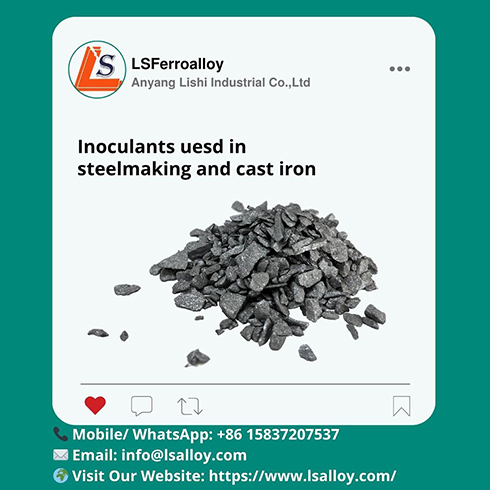In modern manufacturing, from the engine in your daily-driven car to the precision machine tool beds in factories and the water pipelines beneath our cities, these seemingly ordinary yet critical components all rely on one essential material: cast iron. But to achieve the ideal microstructure and mechanical properties in cast iron, there’s a small but mighty player you can’t overlook: inoculant.
So, where exactly is inoculant used in cast iron production? How do different types of cast iron demand different inoculants? What are their key performance priorities? And how does LSFerroalloy, as a specialized inoculant manufacturer, deliver unique value to the industry?

Matching the Inoculant to the Iron: A Strategic Choice
Inoculation is not a one-size-fits-all process. The right choice is a strategic decision that directly impacts the quality, cost, and performance of the final casting. It’s about matching the right tool to the job.
For Gray Iron – The Cost-Performance Balancer
Gray iron is the industry workhorse, used in everything from engine blocks and brake discs to machine tool bases. The goal is balancing cost with function.
For standard grades, Ferrosilicon (FeSi) is the economical choice. It does the basic job of preventing chill, but its effect fades quickly.
When you need higher-grade gray iron or thinner sections, Ferrosilicon-Barium (FeSiBa) becomes the go-to. It boosts strength and, crucially, its anti-fade properties ensure quality remains stable during long pours.
For thin-walled parts requiring gas tightness, like hydraulic valve bodies, Ferrosilicon-Strontium (FeSiSr) is the specialist. It refines the graphite structure, preventing weak spots that could cause leaks.
For Ductile Iron – The High-Performance Alternative to Steel
Here, the focus is on achieving steel-like strength and reliability for parts like crankshafts, wind turbine hubs, and pipes. The priority is maintaining perfect, spherical graphite nodules.
FeSiBa is indispensable. Its long-lasting effect is critical for preserving a high nodule count from the moment of magnesium treatment to the final pour, preventing nodular deterioration.
For the most critical components, Composite Inoculants (FeSiBa enhanced with Calcium, Zirconium, and Rare Earths) are the ultimate tool. This combination cleans the melt, maximizes nodule count, and neutralizes trace elements, delivering peak performance.
For Compacted Graphite Iron (CGI) – The Precision Performer
CGI is the high-tech material for high-performance diesel engine blocks and heavy-duty brake discs. The challenge is promoting graphite nucleation without disrupting its unique vermicular (worm-like) shape.
FeSiSr is the only real choice. It powerfully promotes nucleation without pushing the graphite toward a spherical form, which would ruin the CGI’s unique properties. Using a powerful inoculant like FeSiBa here would be a critical mistake.
Why LSFerroalloy Is Your Strategic Advantage
Choosing an inoculant is a technical decision, but choosing a supplier is a strategic one. You need more than a product; you need a partner. LSFerroalloy is built to be that partner.
?Comprehensive Product Portfolio. Whether you produce gray, ductile, we offer the right solution, from foundational FeSi to advanced, custom-formulated alloys.
?Uncompromising Consistency. Our advanced manufacturing guarantees stable particle size and active element content. This means you get the same, reliable results from every bag, every time.
?Solutions Tailored to Your Foundry. We don’t just sell products; we collaborate. We work with you to customize formulations and addition protocols for your specific furnaces, molding lines, and performance targets.
?A Partner in Sustainability. Our products comply with global environmental standards and support your energy efficiency and carbon reduction goals, helping you build a more sustainable future.
?Expert Support, On-Demand. Our engineers provide end-to-end support. We help you reduce scrap rates, improve yields, and solve your toughest casting challenges.
Conclusion: Small Additive, Massive Impact
To answer the original question: Just how important is inoculant?
The answer is clear: It’s the critical link that transforms cast iron from “functional” to “reliable” and “high-performance.” Whether it’s gray iron balancing cost and damping, ductile iron pushing the limits of strength, or CGI mastering thermal-mechanical synergy—the right inoculant makes all the difference.
And by partnering with a proven supplier like LSFerroalloy, foundries gain more than just a product—they gain a strategic advantage in quality consistency, cost efficiency, sustainability, and market competitiveness.
In the era of high-quality cast iron, inoculant isn’t optional—it’s essential. Choose the right inoculant, and you choose the future of your foundry.
